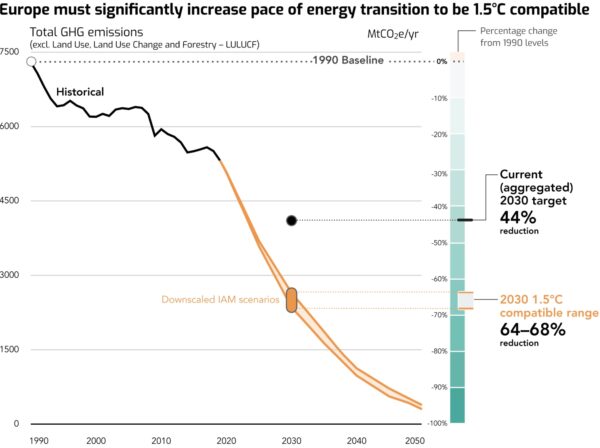1.5°C pathways for the Council of Europe
Authors
Neil Grant, Ryan Wilson, Aman Majid, Lara Welder, Jonas Hörsch, Claire Fyson, Bill Hare
Share

Global action remains insufficient to meet the Paris Agreement’s long-term temperature goal. Increasing the ambition of 2030 climate targets and accelerating emissions reductions in this decade are essential. This report presents technically feasible 1.5°C compatible energy and emissions pathways for the group of countries that make up the Council of Europe (CoE), and assesses whether CoE member states’ current 2030 climate targets (the Nationally Determined Contributions, NDCs) are collectively aligned with limiting warming to 1.5°C.
The report finds that, to be 1.5°C compatible, CoE member states would need to cut their domestic emissions faster than currently planned. Pathways compatible with 1.5°C and filtered to meet sustainability constraints were analysed in this report. These pathways show that countries within the CoE can feasibly:
- Reduce their collective greenhouse gas (GHG) emissions between 63–68% below 1990 levels excl. land use, land use change and forestry (LULUCF). Assuming the minimum LULUCF sink within the CoE region, this corresponds to a 68–73% reduction by 2030, relative to 1990 levels.
- Reach net zero GHG emissions between 2041–2054.
- Limit their total cumulative CO2 emissions to 27–35 GtCO2 from 2020 until mid-century (incl. LULUCF).
If each CoE member state achieved its current individual 2030 NDC target, the total mitigation effect would be a 44% reduction of emissions below 1990 levels. Our analysis therefore suggests that the current 2030 mitigation ambition of the CoE region cannot be seen as compatible with 1.5°C. There is an emissions gap of 1457–1746 MtCO2e in 2030 between the CoE member states’ aggregated NDCs and 1.5°C compatible domestic pathways.
The report also demonstrates how CoE member states could achieve these 1.5°C compatible benchmarks through a rapid transition to an efficient energy system powered by renewable energy sources. It focuses on three illustrative pathways, the HighRE, SSP1 and SusDev scenarios. All three are downscaled versions of Integrated Assessment Model (IAM) pathways taken from the IPCC’s latest assessment report (AR6). They represent different possible 1.5°C compatible futures: the HighRE scenario focuses on renewables deployment and electrification, the SSP1 scenario represents a world in which there are broader shifts towards a more sustainable and equitable society, and the SusDev scenario explicitly focuses on meeting the sustainable development goals alongside the 1.5°C goal. This diversity of pathways improves the robustness of the report’s results.

In the analysed pathways, electricity provides 57–66% of final energy in 2050. There are also strong and sustained reductions in final energy demand, which means that by 2050, total energy demand in the CoE region can be up to 45% lower than in 2019. Overall, renewables provide 39–46% of final energy demand in 2030, rising to 82–91% by 2050.
Fossil fuels are rapidly displaced from the energy system in 1.5°C compatible pathways for the CoE area. In the most ambitious pathways, coal is phased out of the energy system by 2030, and fossil gas by 2050 at the latest. Although residual oil demand remains in 2050, this is concentrated in non-energy demand in the transport, industry and aviation sectors.
Synthetic fuels and feedstocks (which are not represented in the illustrative pathways) could further reduce oil consumption in these sectors.
There is a particularly strong action in the power sector, where rapid deployment of wind and solar is the cornerstone of the energy transition. Key milestones for the power sector in these illustrative pathways include:
- Coal phased out of power generation by 2030 and fossil gas by the mid-2030s
- A 99% fossil fuel free electricity mix by 2035
- Electricity generation more than doubling by 2050
In addition to strengthening domestic climate action, rich member states of the CoE (e.g., the EU27, United Kingdom, and Switzerland, among others) also have an obligation, under the fair share and equity considerations embedded in the Paris Agreement, to assist less wealthy countries to accelerate sustainable economic development and take climate action. Without such assistance, the global effort required to limit warming to 1.5°C could be distributed unfairly and will likely not be enough.
It is clear that member states of the CoE can do more to align with the Paris Agreement’s 1.5°C target and provide global leadership on the climate crisis. By providing updated NDCs that collectively cut emissions by at least 68% (incl. LULUCF) by 2030, by committing to fossil-free electricity by the mid-2030s, and by rapidly reducing demand for fossil fuels, CoE countries can drive ambitious climate action and help keep 1.5°C alive.











